Real Games Have Curves: Welcome to the Competence Zone
Let’s make a graph. The horizontal axis is player skill. On the far left is no skill - just random button-pushing. On the far right is perfect video game godhood, always doing exactly the correct thing at the correct time in the correct way. The first time you play a game, you’ll probably be somewhere in the middle - farther right if you’re a veteran gamer, farther left if you’re a novice. As you play the game, and learn its mechanics, you’ll trend right as you get better.
The vertical axis is performance level. At the very bottom is complete failure - game over as quickly as possible, not achieving any of the game’s goals. Farther up is the passing line, separating failure below from success above. The line itself is a performance level of just barely passing a challenge - surviving the boss fight with one hit point left, clearing the race course just before the clock runs out, and so on. And at the very top of the axis is absolute perfect performance - winning by the largest margin possible.
Now we can chart the performance levels achievable with a particular amount of player skill: the “skill curve” for a given challenge.
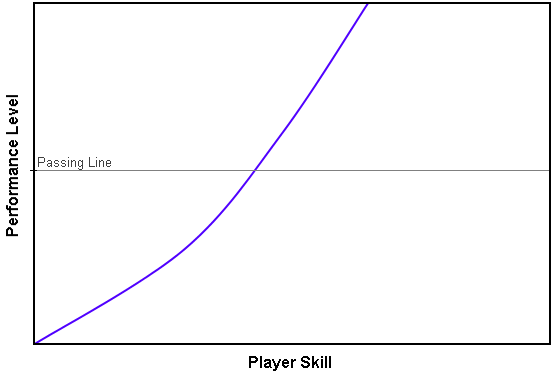
Here’s a skill curve for a song in Guitar Hero. The player must be fairly skilled to hold the right frets and strum at the right time, but does not have to be perfect in order to pass the song. Failing to hit notes drains a life meter, and when the meter empties, the player fails the song - but hitting notes correctly refills the meter. As long as the player doesn’t miss too many notes in a row it’s possible to miss a lot of them and still pass the song. This leaves plenty of room to improve - hitting a greater percentage of the notes earns the player a higher score, up to the perfect combo of hitting every single note.
The area between just barely passing and playing perfectly is the “competence zone.” A player with skill in this range is competent to pass a challenge, but not necessarily expert in it.
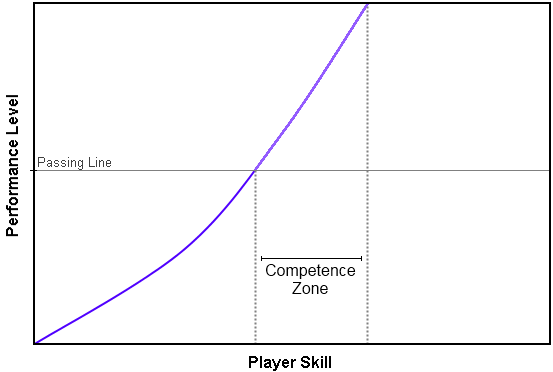
Guitar Hero songs can, of course, be played on different difficulty settings. Above might be the skill curve for a particular song on Medium. Switch to Easy and the curve moves left; switch to Hard and the curve moves right. The higher the difficulty is set, the more complex is the pattern of notes to be hit, and the more skill is required to perform at a given level. The game still allows the player to miss many of the notes and pass the song, so the competence zone is the same size and shape.
Let’s compare this to Elite Beat Agents, a rhythm game for the Nintendo DS. Much like Guitar Hero, EBA features a sequence of notes that must be hit to pass a song, with missed notes draining a life meter and hit notes filling it. However, EBA introduces another factor - the life meter constantly drains over time. On low difficulties, the drain rate is slow, and there is not much effect on gameplay. But the life meter drains faster on higher difficulties, drastically reducing the safety net.
Here are skill curves for a song in EBA on the easiest difficulty and the hardest. On the harder difficulty, not only does the curve slide right because the note pattern has become more complex, but the curve also steepens because the player is allowed to miss far fewer notes before failure. The result is that the competence zone is much smaller - the player has to be much closer to perfect in order to simply pass.
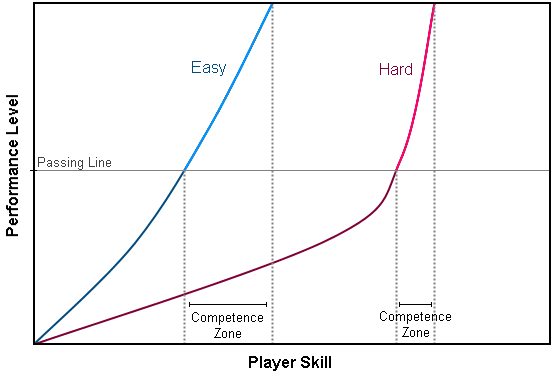
It’s a bit like moving an archery target farther away and making it smaller at the same time. It’s harder to hit, and there is less margin for error. It requires more skill to perform at the same relative level - hit the same distance from the center of the target, or miss the same number of notes - but that level might also no longer be good enough.
Now let’s consider Bit.Trip Runner.
Choice Provisions’s fourth outing on WiiWare, Bit.Trip Runner has been well received. Like its predecessors, it’s a graphically and musically nostalgic rhythm game - but Runner takes the form of a sidescrolling platformer. It’s a bit like if Guitar Hero rotated the fretboard ninety degrees and instead of scrolling colored notes at you, disguised them as various hazards and obstacles that must be reacted to appropriately - but these actions still occur in rhythm, and create music.
My two favorite genres happen to be rhythm games and platformers. And if you’re anything like me, the trailer alone demands that you purchase the game immediately - especially at its eight dollar price point.
If you are like me, you’ll also notice the trailer doesn’t show what happens when the player fails to avoid a hazard. That’s nothing unusual, of course - marketing material generally shows success rather than failure, to make games look more fun. But because this is a rhythm game, the pacing is vital. If Commander Video (the player character) were to stumble on an obstacle, it would mess up the timing of the level and therefore the song. So the trailer left me rather curious as to how Runner maintains its momentum.
Its solution turns out to be quite simple: hit one obstacle, and Commander Video is immediately sent back to the very beginning of the level. This occurs no matter how much of the level the player has traversed - there are no mid-level checkpoints. Trip over a ledge, and you have to replay the entire level up to that point. It’s a bit like if Guitar Hero restarted the song every time the player missed a note.
It’s a punishing strategy, and it becomes more punishing the longer the levels get. It’s enough to make Bit.Trip Runner qualify as a Bad Good Game. Since any failure to avoid an obstacle means restarting the level, the player’s performance must be near-perfect in order to beat a level. In other words, the competence zone is vanishingly small.
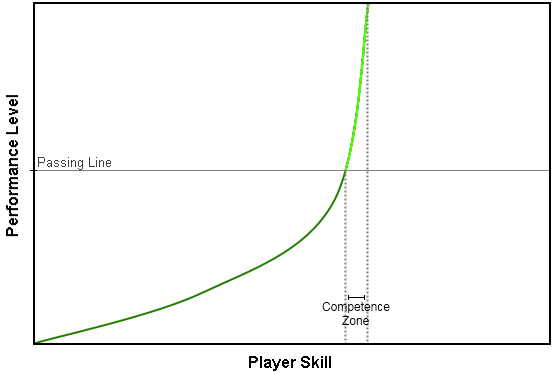
By showcasing the frustration that comes with a tiny competence zone, Bit.Trip Runner inadvertently demonstrates how important the competence zone really is - it’s the only part of the skill curve in which flow can occur.
I’ve mentioned flow before - it’s a fascinating, broadly useful concept. In games, flow is what happens when the challenge level is perfectly tuned to the player’s skill and presents clear goals and clear feedback: the player loses themselves in the challenge and tunes out the rest of the world, and applies their skill to just barely manage to prevail. It’s an incredibly satisfying feeling and it enhances learning - it’s absolutely the best experience a skill-based game can deliver. Therefore, a well-designed skill-based game should provide as much opportunity for the player to achieve flow as it possibly can - which means it should have as large a competence zone as possible. There should be lots of room between passing and perfect.
Let’s compare the experience of two players, one playing a song in Guitar Hero and the other playing a level in Bit.Trip Runner. Both start with skill too low to pass, but they practice and get better. They’re both still making mistakes, but they are making fewer of them, and less often. Eventually, our Guitar Hero player is good enough to just barely pass the song. Eureka! Flow is achieved. Meanwhile, our Runner player is still failing, still having an experience interrupted by frustrating level restarts.
The Guitar Hero player now formulates a new goal - to score better on the song, perhaps earning four stars, then five. Each goal is just within reach, and flow is maintained as the player becomes increasingly skilled. The Runner player is still working on the same goal of simply passing the level. Flow has not yet been achieved.
Once skilled enough to achieve a nearly perfect performance, the Runner player finally achieves flow and beats the level. From this point, it’s a fairly short journey for both players to become good enough to play flawlessly, after which flow is no longer possible because the challenge level cannot match player skill.
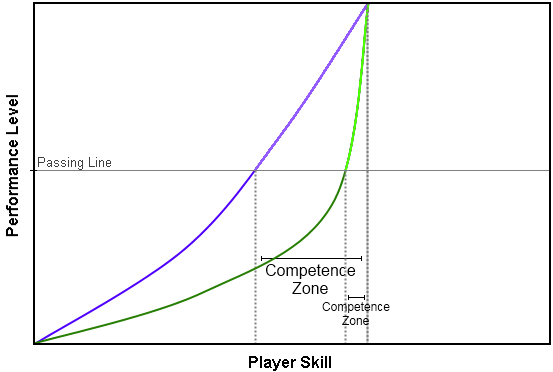
The Guitar Hero player had much, much more opportunity for flow, due to the much larger competence zone. The Runner player had only a small window - assuming they persevered through the long period of frustration and didn’t simply quit. By presenting a tiny competence zone, Bit.Trip Runner robs the player of a great deal of potential enjoyment.
So what happens when things are taken in the other direction, and the competence zone is expanded to huge dimensions?
Rock Band 3 might be about to show us.
In addition to its various other enhancements over previous installments (such as having a keyboard controller for piano parts), Rock Band 3 features a new “Pro” mode, which is actually designed to bridge the gap between playing fake plastic instruments and the real thing.
“Drums are fairly straightforward – strap the three Mad Catz cymbals to your existing Rock Band 2 (or The Beatles: Rock Band) kit and you’re good to go. . . . Pro Keyboards are a bit more interesting, taking advantage of the entire two-octave keyboard and having the player actually tapping out real notes. . . . But the real news here is the game’s support for a Pro Guitar, a new peripheral distributed by Mad Catz. Based on the Fender Mustang, the guitar features 17 frets and six strings, for a total of – are you sitting down? – 102 buttons on the fretboard. The guitar also features six ‘strings’ for picking out and strumming notes.
In case you don’t see where this is going – like the Pro Keyboard, the guitar charts in this mode will actually have you playing the notes in the song. . . . [A]s a guitarist, it was easy to see that all of the notes were in the right places, from the power chords to the individual notes in the song’s blistering solo.
Harmonix understands that these most difficult modes won’t be for everyone, but it’s an interesting bridge between simply playing a game and holding a real guitar in your hands. Starting at the easiest level, it’s likely that most players (especially those who’ve played Rock Band guitar on expert) will feel at home. Before they know it, the idea is to get them more comfortable with a real six-string axe.
‘Our perspective on this is to not necessarily to turn people into virtuoso guitar players,’ Sussman says. ‘I think the line that we use in the studio is that we want to get you to the point where you can beat out a song at a campfire, and not necessarily jump on stage. But what we’ve seen in our focus testing is that after an hour of, kind of, trainer development and a couple of songs, people actually come out of that one hour and they have basic guitar chops.'"
—Nick Chester, Pre-E3: Hands-on with the ‘disruptive’ Rock Band 3
It’s too early to say yet whether Rock Band 3 will succeed in its goal. But if it does, Harmonix will accomplish something amazing. They will solve the problem that it takes a long time and a lot of practice before learning an instrument becomes rewarding. They will connect the competence zones of the game and the real instruments. Learning will be a smooth, satisfying ride all the way up.
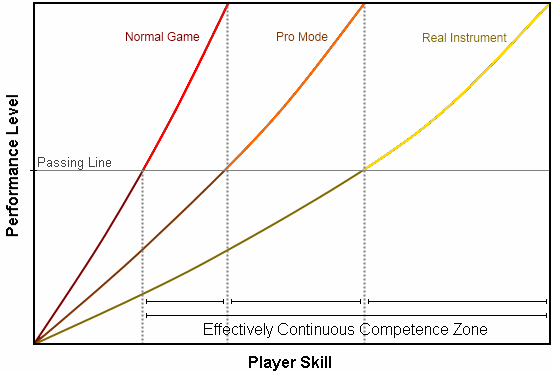
I’ve mainly discussed the competence zone in relation to rhythm games. But it applies to any skill-based endeavor. The size of the competence zone is the answer to the question, “How badly and how many times can I screw up before I have failed?” Easy to overlook, but deeply important to enjoyment and learning, it’s a significant facet of challenge.